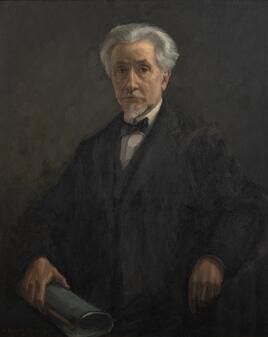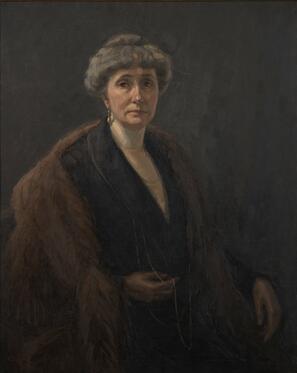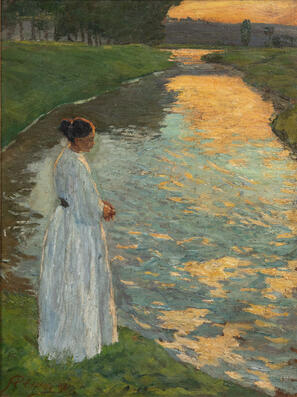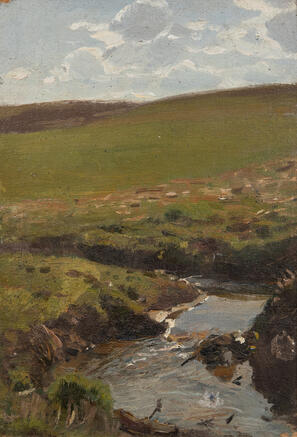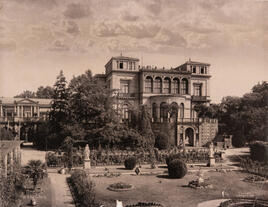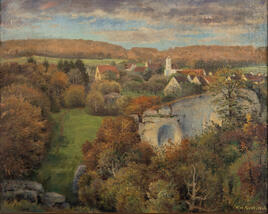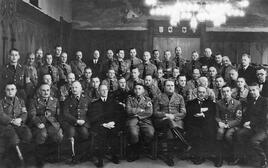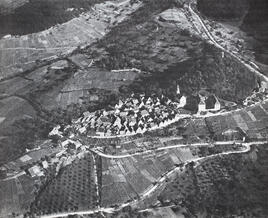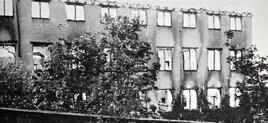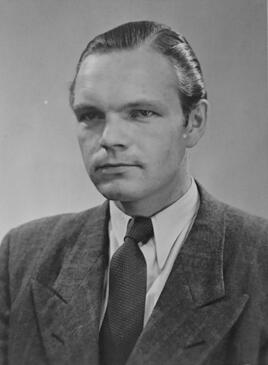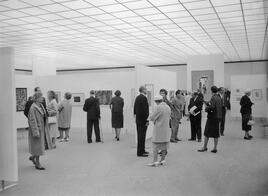History
The history of the Kunstmuseum Stuttgart is closely tied to the history of the art collection of the City of Stuttgart. The institution has borne the name "museum" only since 2005; previously, up to 1961, the city’s art collection was called the Städtische Galerie (municipal gallery), and beginning in 1961, Galerie der Stadt Stuttgart (Stuttgart city gallery).
1924: Casanova’s Gift
The first artwork acquisitions on behalf of the city date from 1913. The foundation for the collection was laid in 1924 by a private individual: in remembrance on his happy student years, Count Silvio della Valle di Casanova, a scion of Neapolitan high nobility, bequeathed his painting collection to the City of Stuttgart. His passion for Richard Wagner and German literature had led him to the Conservatory in Stuttgart in 1883. It was not until thirteen years later that Casanova, by then married to the Irish landscape painter Sophie Browne, returned to Pallanza on Lake Maggiore. During his years in Stuttgart, he amassed an extensive collection with works off so-called Swabian Impressionism. Casanova remained connected to Stuttgart and the region throughout his life, so that he decided to leave the paintings to the City of Stuttgart.
1925–32:
The Municipal Painting Collection at the Villa Berg
Casanova linked the donation of his collection with his wish that the works be displayed permanently in a public space. On May 28, 1925, fifty-three paintings were shown for the first time in the Villa Berg as the "Städtische Gemäldesammlung" (Municipal Painting Collection) in the presence of the donor couple. Due to its upscale atmosphere and prominent location, the villa, built in 1853 for Crown Prince Karl of Württemberg and his wife, Olga Nikolaevna of Russia, offered an ideal setting for the art collection. The public presentation of the donation marked the beginning of Stuttgart’s effort to emphasize its cultural significance for the region as well as for the Weimar Republic—"to join the ranks of the cities that build their own cultural sites for the fine arts," as mayor Karl Lautenschlager remarked in his opening speech.
Subsequently, the municipality also provided an annual acquisition budget for art. Even so, the collection, was only modestly enlarged during this time; we could scarcely speak of a systematic expansion or further development. The works purchased chiefly served as office decoration in municipal facilities. The course for the development of a municipal art museum in Stuttgart would first be paved in the Third Reich via the art and cultural policies of the National Socialists.
1933–45:
The Museum in National Socialism
The National Socialists in Stuttgart paid great attention to art and culture and thus their art and cultural policy was quite far-reaching. From 1933 to 1945 the city bought many artworks, especially by regional artists, to create a municipal art museum that collected, preserved, and exhibited art. Several private art collections were acquired; particularly during the war years politicians invested enormous sums of money. In 1943, after a decade of National Socialist city administration, the mayor at the time, Karl Strölin, took stock: "In total, the City of Stuttgart has since 1933 made purchases worth 1.1 million reichsmarks for its holdings of art alone. With these purchases, a valuable foundation has now been laid for the future municipal art museum." For comparison: in the eight years of the Weimar Republic, the municipal budget for art acquisitions comprised just some 200,000 reichsmarks.
In addition, a department of culture and art as well as an art commission were established in the city administration for the first time, which were responsible for making and cataloguing art purchases. The National Socialists’ art-policy activities were meant to culminate in the building of an art museum.
"The goal should be to acquire the best works from the artists born or active in Stuttgart in a characteristic selection and to present them permanently to the public in collections arranged in a gallery-like fashion (masters’ rooms) in a suitable exhibition building. . . . The goal being considered is a future municipal art museum, since the rooms of the Villa Berg are already too small even for the current holdings. A good art collection shouldn’t remain distributed among law firms and government offices; it needs to work together to give noble joy and pleasure to the population and offer inspiration to our young artists."
Fritz Cuhorst, 1942
These plans were not realized. In 1942, because of the war, the largest parts of the collection were evacuated to sites places then considered safe—first to Schloss Löwenstein and to the Kochendorf and Heilbronn salt mines. The Villa Berg burned down in 1944, and in 1945 Schloss Löwenstein was completely destroyed, obliterating a considerable part of the art collection stored there.
1961–2005:
Galerie der Stadt Stuttgart
The museum concept that emerged during fascism lived on in the postwar period. But after the destruction of the Villa Berg in World War II, it lacked an exhibition site. It was only in 1961 that the Galerie der Stadt Stuttgart found a new home in the architect Theodor Fischer’s rebuilt art building on Schlossplatz, where it shared the exhibition spaces with the Württembergische Kunstverein. Acquiring works from the region also remained a priority after World War II. Eugen Keuerleber, who had taken care of the municipal art collection since 1945 and was the Galerie’s first director (1961–86), set his focus on Baden-Württemberg art of the nineteenth and twentieth centuries. He bought works by Adolf Hölzel and those in his circle, which included Willi Baumeister, Oskar Schlemmer, Ida Kerkovius, and Johannes Itten. Keuerleber deserves the greatest recognition for his engagement on behalf of the works by Otto Dix, which today comprise the central focus of the collection.
Keuerleber’s successor, Johann Karl Schmidt, who held the position from 1986 to 2003, concentrated on painting tendencies in the southwest from the 1950s to 1980s, adding areas of emphasis to the collection—such as new figuration and Art Informel—that are still important today. He devoted himself with particular intensity to the work of Diether Roth, Joseph Kosuth, and Wolfgang Laib. In addition, important collections were acquired as permanent loans under Schmidt’s aegis: the Rudolf and Bertha Frank Collection in 1992, and the Konrad Knöpfel-Stiftung Fritz Winter in 1994.
To present the collection of contemporary art in a manner corresponding to its quality and quantity, an architecture competition for a new museum building was held in 1999, which was won by the architecture firm Hascher+Jehle. The groundbreaking took place on October 12, 2002. Located close to Königstrasse and visible from afar, the glass cube encloses a stone cube, which houses around a fifth of the exhibition space. The far greater portion of the 5,000-square meters is located below the Kleine Schlossplatz, in a former traffic tunnel. Whereas the two lower levels are primarily reserved for the presentation of the collection, temporary exhibitions are shown in the Cube.
2005 to the present:
Kunstmuseum Stuttgart
With the new museum, the municipal art collection had, in 2005, eighty years after its founding, finally arrived in a building of its own, under Director Marion Ackermann. It was given the name Kunstmuseum Stuttgart. The mayor at the time, Wolfgang Schuster, was particularly committed to the realization of the new building. It is not only this engagement that demonstrates the high value that the City of Stuttgart continues to attach to art today. Since its opening, the museum has also housed the Archiv Baumeister. In 2009, the addition of the Teufel Collection brought an extensive assortment of Concrete Art works into the museum’s holdings.
Since 2010 the Kunstmuseum Stuttgart has been under the directorship of Ulrike Groos. Her areas of focus are the strengthening of the collection’s intrinsic character; looking to the future with exhibitions of work by young artists, who are given their first solo show in the Kunstmuseum; and working closely with private collectors. Groos recently set new accents in the collection with works by Michel Majerus and Tim Berresheim, for instance, as well as with an emphasis on women artist such as Hanne Brenken, Katinka Bock, Gego, Annette Kelm, Josephine Meckseper, and Katrin Ströbel. The museum is continually expanding its collaborations with other Stuttgart and Baden-Württemberg cultural institutions.
As an outpost of the museum, the Museum Haus Dix in Gaienhofen-Hemmenhofen on Lake Constance was opened in 2013. Under Groos provenance research and digitization projects have also been initiated.
